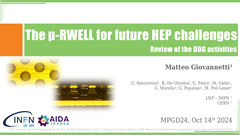The micro-RWELL for future HEP challenges and beyond
ID:95
View Protection:ATTENDEE
Updated Time:2024-10-14 02:21:37
Hits:447
Oral Presentation
Abstract
The challenges posed by the forthcoming High-Energy Physics experiments, necessitate the development of particle detection technologies that are easily engineered and compatible with industrial-scale production. The micro-RWELL, a single-amplification stage resistive MPGD based on sequential build-up technology, effectively meets these demands. In this contribution, we provide an overview of the detector characteristics, outlining the design and testing steps conducted at INFN-LNF. Additionally, we offer a schematic description of the construction processes performed at the ELTOS Company and CERN MPT Workshop.
The experience detailed in this contribution indicates that a significant portion of the detector construction can be effectively carried out by the industry, providing substantial advantages in terms of production time and cost-effectiveness. Furthermore, it is crucial to highlight the significant effort invested in the production of large DLC (Diamond-Like-carbon) foils, a fundamental component of the detector amplification stage. The acquisition of the DC-magnetron sputtering machine, a fruitful joint venture between CERN and INFN, represents a crucial development, allowing a remarkable advancement in this technology.
The results of the tests carried out with an X-ray gun at LNF and particle beams at the CERN North Area beam facility are then discussed in detail. Preliminary outcomes of the co-production pilot test performed in 2023 are summarized, indicating a production yield of approximately 90%. The fruitful experience gained in this phase of the technology transfer is a first step towards the construction of larger detectors, as envisaged for the forthcoming challenges in HEP.
In parallel with the technology transfer to industry and the refinement of the detector construction process, aimed at meeting the significant construction challenges of future large-scale High Energy Physics experiments, we have pursued various R&Ds to optimize the micro-RWELL detector for other applications. These include their deployment as fine tracking detectors for the Muon system of FCC-ee, the development of a low-mass cylindrical micro-RWELL for the Inner Tracker of low momentum e⁺e⁻ colliders, and the creation of a simplified micro-RWELL for use as a slow neutron sensor in Radiation Portal Monitors for airports or ports in Homeland Security applications.
The challenges posed by the forthcoming High-Energy Physics experiments, necessitate the development of particle detection technologies that are easily engineered and compatible with industrial-scale production. The micro-RWELL, a single-amplification stage resistive MPGD based on sequential build-up technology, effectively meets these demands. In this contribution, we provide an overview of the detector characteristics, outlining the design and testing steps conducted at INFN-LNF. Additionally, we offer a schematic description of the construction processes performed at the ELTOS Company and CERN MPT Workshop.
The experience detailed in this contribution indicates that a significant portion of the detector construction can be effectively carried out by the industry, providing substantial advantages in terms of production time and cost-effectiveness. Furthermore, it is crucial to highlight the significant effort invested in the production of large DLC (Diamond-Like-carbon) foils, a fundamental component of the detector amplification stage. The acquisition of the DC-magnetron sputtering machine, a fruitful joint venture between CERN and INFN, represents a crucial development, allowing a remarkable advancement in this technology.
The results of the tests carried out with an X-ray gun at LNF and particle beams at the CERN North Area beam facility are then discussed in detail. Preliminary outcomes of the co-production pilot test performed in 2023 are summarized, indicating a production yield of approximately 90%. The fruitful experience gained in this phase of the technology transfer is a first step towards the construction of larger detectors, as envisaged for the forthcoming challenges in HEP.
In parallel with the technology transfer to industry and the refinement of the detector construction process, aimed at meeting the significant construction challenges of future large-scale High Energy Physics experiments, we have pursued various R&Ds to optimize the micro-RWELL detector for other applications. These include their deployment as fine tracking detectors for the Muon system of FCC-ee, the development of a low-mass cylindrical micro-RWELL for the Inner Tracker of low momentum e⁺e⁻ colliders, and the creation of a simplified micro-RWELL for use as a slow neutron sensor in Radiation Portal Monitors for airports or ports in Homeland Security applications.
Keywords
MPGG,Gaseous detectors,diamond-like carbon,resistive detectors




Comment submit